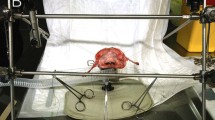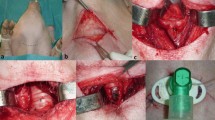Abstract
Open reconstructive upper airway surgery for laryngotracheal stenosis (LTS), whether for subglottic or tracheal stenosis, constitutes a group of complex approaches. LTS requiring open reconstruction is overall rare and primarily performed at tertiary centres. This poses an obvious challenge for the acquisition and maintenance of surgical skills for this group of complex approaches. In this context, animal models provide a unique opportunity for open reconstructive airway surgery training. Such models ought to take into consideration ethical aspects, be easily available and easy to maintain, and have similar macroscopic anatomical features to the human laryngotracheal frame. Here, we provide a brief surgical guide for the use of refashioned lamb tissue as a training model for surgery of adult and pediatric reconstructive airway surgery. The techniques of laryngotracheal reconstruction, partial cricotracheal resection, tracheal resection with end-to-end anastomosis, and slide tracheoplasty are presented. Proper training in open LTS surgery is challenging, time consuming and its complexity further lengthens the learning curve. The lamb larynx and trachea model is an effective model for practising various airway reclaiming surgeries.








Similar content being viewed by others
References
Lorenz RR (2003) Adult laryngotracheal stenosis: etiology and surgical management. Curr Opinion Otolaryngol Head Neck Surg 11(6):467–472
Cotton RT (1984) Pediatric laryngotracheal stenosis. J Pediatr Surg 19(6):699–704
Szmuk P, Ezri T, Evron S, Roth Y, Katz J (2008) A brief history of tracheostomy and tracheal intubation, from the bronze age to the space age. Intensive Care Med 34(2):222–228. doi:10.1007/s00134-007-0931-5
Koempel JA, Cotton RT (2008) History of pediatric laryngotracheal reconstruction. Otolaryngol Clin North Am 41(5):825–835. doi:10.1016/j.otc.2008.04.014 vii.
Sandu K, Monnier P (2008) Cricotracheal resection. Otolaryngol Clin N Am 41(5):981–998. doi:10.1016/j.otc.2008.04.012 x.
Hartley BE, Cotton RT (2000) Paediatric airway stenosis: laryngotracheal reconstruction or cricotracheal resection? Clin Otolaryngol Allied Sci 25(5):342–349
Monnier P, Dikkers FG, Eckel H, Sittel C, Piazza C, Campos G, Remacle M, Peretti G (2015) Preoperative assessment and classification of benign laryngotracheal stenosis: a consensus paper of the European Laryngological Society. Eur Arch Oto-Rhino-Laryngol. 272 (10):2885–2896. doi:10.1007/s00405-015-3635-4
Nasser Kotby M, Wahba HA, Kamal E, El-Makhzangy AM, Bahaa N (2012) Animal model for training and improvement of the surgical skills in endolaryngeal microsurgery. J Voice Off J Voice Found 26(3):351–357. doi:10.1016/j.jvoice.2011.04.002
Nixon IJ, Palmer FL, Ganly I, Patel SG (2012) An integrated simulator for endolaryngeal surgery. Laryngoscope 122(1):140–143. doi:10.1002/lary.22441
Dedmon MM, Paddle PM, Phillips J, Kobayashi L, Franco RA, Song PC (2015) Development and validation of a high-fidelity porcine laryngeal surgical simulator. Otolaryngol Head Neck Surg. 153 (3):420–426. doi:10.1177/0194599815590118
Bailey M, Hoeve H, Monnier P (2003) Paediatric laryngotracheal stenosis: a consensus paper from three European centres. Eur Arch Oto-Rhino-Laryngol 260(3):118–123. doi:10.1007/s00405-002-0526-2
Bajaj Y, Cochrane LA, Jephson CG, Wyatt ME, Bailey CM, Albert DM, Hartley BE (2012) Laryngotracheal reconstruction and cricotracheal resection in children: recent experience at Great Ormond Street Hospital. Int J Pediatr Otorhinolaryngol 76(4):507–511. doi:10.1016/j.ijporl.2012.01.006
George M, Ikonomidis C, Jaquet Y, Monnier P (2009) Partial cricotracheal resection in children: potential pitfalls and avoidance of complications. Otolaryngol Head Neck Surg 141(2):225–231. doi:10.1016/j.otohns.2009.04.019
Yamamoto K, Jaquet Y, Ikonomidis C, Monnier P (2015) Partial cricotracheal resection for paediatric subglottic stenosis: update of the Lausanne experience with 129 cases. Eur J Cardio-Thoracic Surg. 47 (5):876–882. doi:10.1093/ejcts/ezu273
Stern Y, Gerber ME, Walner DL, Cotton RT (1997) Partial cricotracheal resection with primary anastomosis in the pediatric age group. Ann Otol Rhinol Laryngol 106(11):891–896. doi:10.1177/000348949710601102
Jaquet Y, Lang F, Pilloud R, Savary M, Monnier P (2005) Partial cricotracheal resection for pediatric subglottic stenosis: long-term outcome in 57 patients. J Thorac Cardiovasc Surg 130(3):726–732. doi:10.1016/j.jtcvs.2005.04.020
Triglia JM, Nicollas R, Roman S (2001) Primary cricotracheal resection in children: indications, technique and outcome. Int J Pediatr Otorhinolaryngol 58(1):17–25
Ikonomidis C, George M, Jaquet Y, Monnier P (2010) Partial cricotracheal resection in children weighing less than 10 kilograms. Otolaryngol Head Neck Surg 142(1):41–47. doi:10.1016/j.otohns.2009.10.024
HC G (2004) Congenital and acquired tracheal lesions in children. BC Decker Inc, Ontario
Gallagher TQ, Hartnick CJ (2012) Tracheal resection and reanastomosis. Adv Otorhinolaryngol 73:50–57. doi:10.1159/000334299
Har-El G, Shaha A, Chaudry R, Lucente FE (1993) Resection of tracheal stenosis with end-to-end anastomosis. The Annals of otology, rhinology, and laryngology. 102 (9):670–674. doi:10.1177/000348949310200904
Elliott M, Hartley BE, Wallis C, Roebuck D (2008) Slide tracheoplasty. Current opinion in otolaryngology & head and neck surgery 16. (1):75–82. doi:10.1097/MOO.0b013e3282f45ab7
Rethi A (1956) An operation for cicatricial stenosis of the larynx. J Laryngol Otol 70(5):283–293
Fearon B, Cotton R (1972) Surgical correction of subglottic stenosis of the larynx. Preliminary report of an experimental surgical technique. The Annals of otology, rhinology, and laryngology. 81 (4):508–513. doi:10.1177/000348947208100408
Propst EJ TY, Abdulkader FI, Estrada M, Campsisi P, Forte V (2014) Airway reconstruction surgical dissection manual. Plural Publishing, Inc, San Diego
Effat KG (2005) The laryngeal dissection laboratory. J Laryngol Otol 119(12):981–984. doi:10.1258/002221505775010841
Zrunek M, Happak W, Hermann M, Streinzer W (1988) Comparative anatomy of human and sheep laryngeal skeleton. Acta Otolaryngol 105(1–2):155–162
Ianacone DC, Gnadt BJ, Isaacson G (2016) Ex vivo ovine model for head and neck surgical simulation. Am J Otolaryngol 37(3):272–278. doi:10.1016/j.amjoto.2016.01.015
Franco RA, Dowdall JR, Bujold K, Amann C, Faquin W, Redmond RW, Kochevar IE (2011) Photochemical repair of vocal fold microflap defects. Laryngoscope 121(6):1244–1251. doi:10.1002/lary.21797
Bauer F, Rommel N, Kreutzer K, Weitz J, Wagenpfeil S, Gulati A, Wolff KD, Kesting MR (2014) A novel approach to teaching surgical skills to medical students using an ex vivo animal training model. J Surg Educ 71(4):459–465. doi:10.1016/j.jsurg.2014.01.017
Farwell DG, Birchall MA, Macchiarini P, Luu QC, de Mattos AM, Gallay BJ, Perez RV, Grow MP, Ramsamooj R, Salgado MD, Brodie HA, Belafsky PC (2013) Laryngotracheal transplantation: technical modifications and functional outcomes. Laryngoscope 123(10):2502–2508. doi:10.1002/lary.24053
Author information
Authors and Affiliations
Corresponding author
Ethics declarations
Funding
No funding.
Conflict of interest
No conflict of interest.
Ethical standards
All applicable institutional guidelines for the care and use of animals were followed.
Additional information
Lluís Nisa, Pedro Teiga, Gustavo Barreto da Cunha, Biswanath Roy, Riza Onder Gunaydin, Kishore Sandu contributed equally.
Rights and permissions
About this article
Cite this article
Nisa, L., Teiga, P., da Cunha, G.B. et al. Refashioned lamb tissue as an animal model for training complex techniques of laryngotracheal stenosis surgery. Eur Arch Otorhinolaryngol 274, 4169–4181 (2017). https://doi.org/10.1007/s00405-017-4775-5
Received:
Accepted:
Published:
Issue Date:
DOI: https://doi.org/10.1007/s00405-017-4775-5




